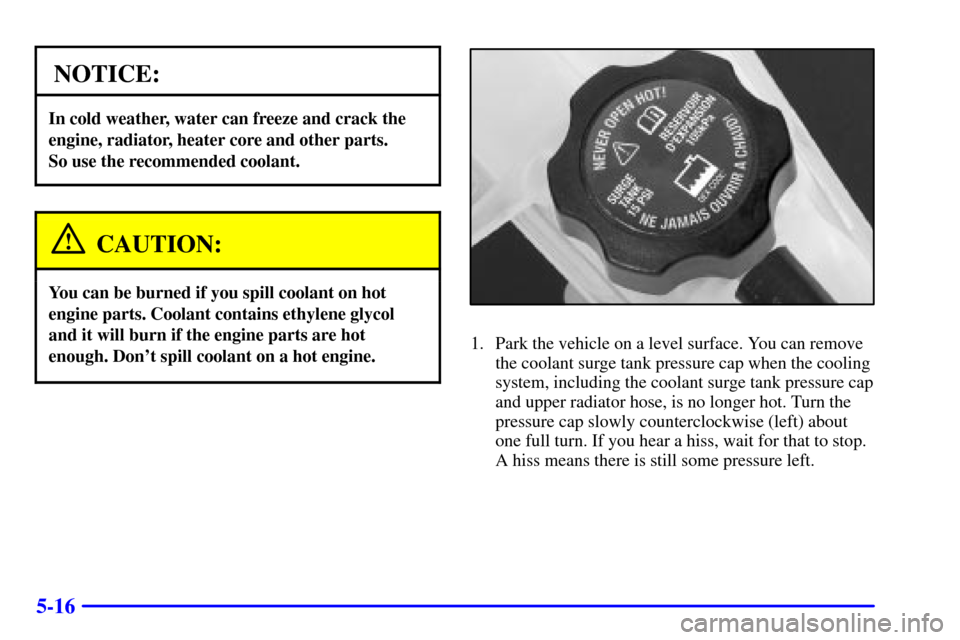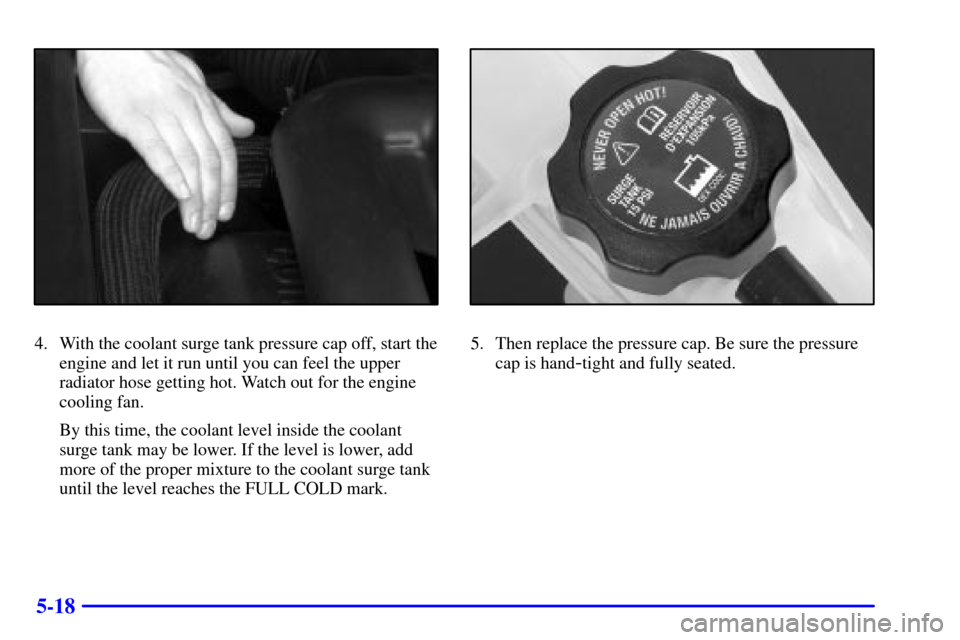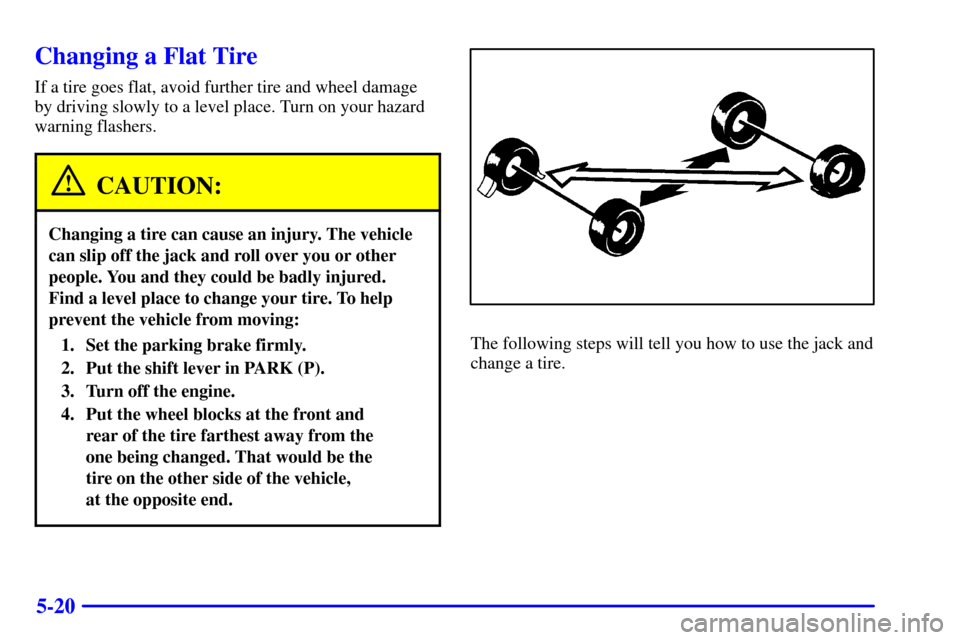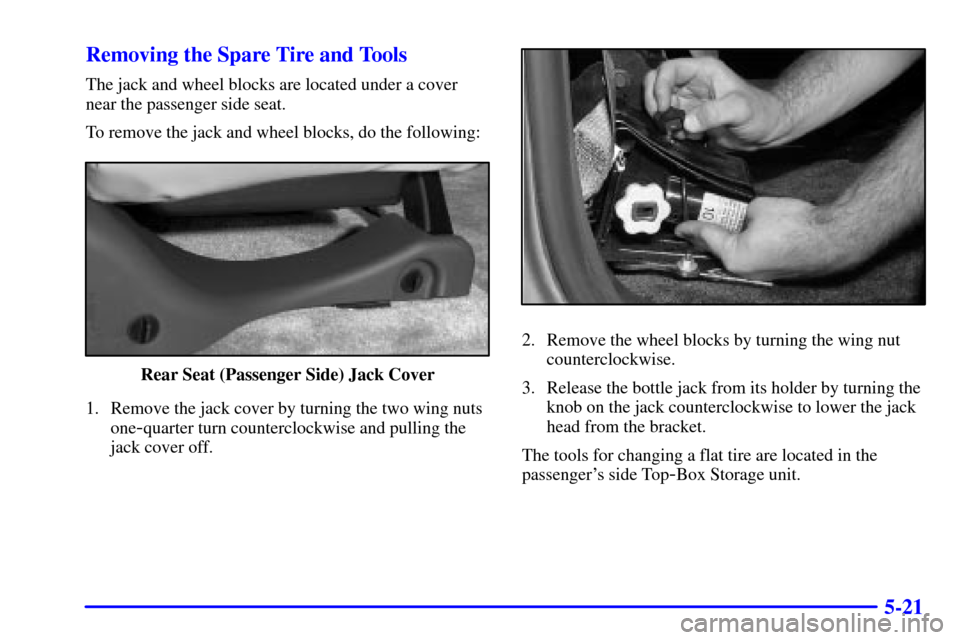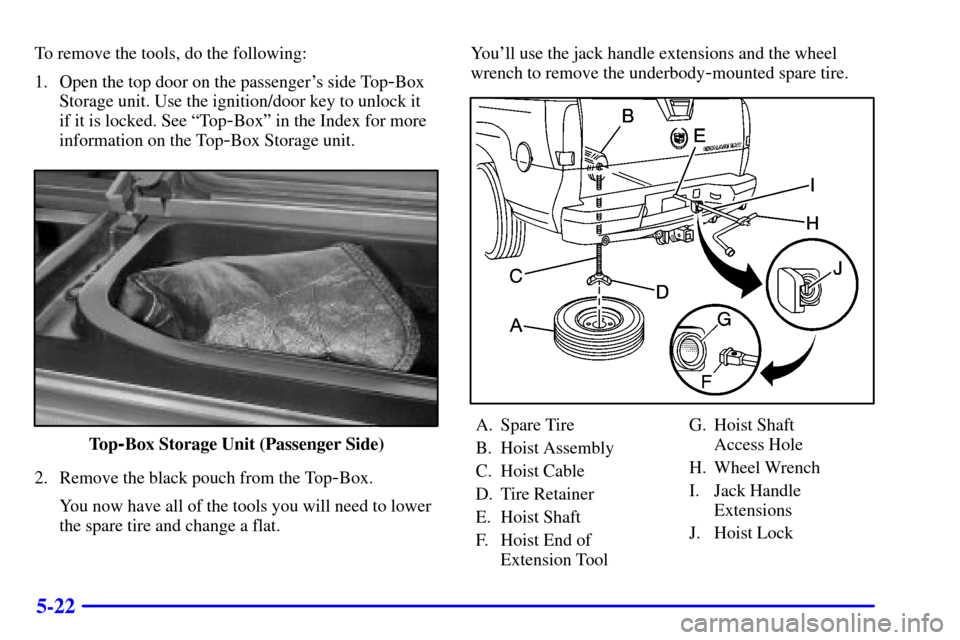CADILLAC ESCALADE EXT 2002 2.G Owners Manual
ESCALADE EXT 2002 2.G
CADILLAC
CADILLAC
https://www.carmanualsonline.info/img/23/7924/w960_7924-0.png
CADILLAC ESCALADE EXT 2002 2.G Owners Manual
Trending: window, wiper fluid, transmission, lug pattern, refrigerant type, oil capacity, battery
Page 291 of 427
5-16
NOTICE:
In cold weather, water can freeze and crack the
engine, radiator, heater core and other parts.
So use the recommended coolant.
CAUTION:
You can be burned if you spill coolant on hot
engine parts. Coolant contains ethylene glycol
and it will burn if the engine parts are hot
enough. Don't spill coolant on a hot engine.
1. Park the vehicle on a level surface. You can remove
the coolant surge tank pressure cap when the cooling
system, including the coolant surge tank pressure cap
and upper radiator hose, is no longer hot. Turn the
pressure cap slowly counterclockwise (left) about
one full turn. If you hear a hiss, wait for that to stop.
A hiss means there is still some pressure left.
Page 292 of 427
5-17
2. Then keep turning the pressure cap slowly, and
remove it.3. Then fill the coolant surge tank with the proper
mixture, to the FULL COLD mark.
Page 293 of 427
5-18
4. With the coolant surge tank pressure cap off, start the
engine and let it run until you can feel the upper
radiator hose getting hot. Watch out for the engine
cooling fan.
By this time, the coolant level inside the coolant
surge tank may be lower. If the level is lower, add
more of the proper mixture to the coolant surge tank
until the level reaches the FULL COLD mark.5. Then replace the pressure cap. Be sure the pressure
cap is hand
-tight and fully seated.
Page 294 of 427

5-19
Engine Fan Noise
Your vehicle has a clutched engine cooling fan.
When the clutch is engaged, the fan spins faster to
provide more air to cool the engine. In most everyday
driving conditions, the fan is spinning slower and
the clutch is not fully engaged. This improves fuel
economy and reduces fan noise. Under heavy vehicle
loading, trailer towing and/or high outside temperatures,
the fan speed increases as the clutch more fully engages.
So you may hear an increase in fan noise. This is
normal and should not be mistaken as the transmission
slipping or making extra shifts. It is merely the cooling
system functioning properly. The fan will slow down
when additional cooling is not required and the
clutch disengages.
You may also hear this fan noise when you start
the engine. It will go away as the fan clutch
partially disengages.
If a Tire Goes Flat
It's unusual for a tire to ªblow outº while you're driving,
especially if you maintain your tires properly. If air goes
out of a tire, it's much more likely to leak out slowly.
But if you should ever have a ªblowout,º here are a
few tips about what to expect and what to do:
If a front tire fails, the flat tire will create a drag that
pulls the vehicle toward that side. Take your foot off
the accelerator pedal and grip the steering wheel firmly.
Steer to maintain lane position, and then gently brake
to a stop well out of the traffic lane.
A rear blowout, particularly on a curve, acts much like
a skid and may require the same correction you'd use
in a skid. In any rear blowout, remove your foot from
the accelerator pedal. Get the vehicle under control by
steering the way you want the vehicle to go. It may be
very bumpy and noisy, but you can still steer. Gently
brake to a stop
-- well off the road if possible.
If a tire goes flat, the next part shows how to use your
jacking equipment to change a flat tire safely.
Page 295 of 427
5-20
Changing a Flat Tire
If a tire goes flat, avoid further tire and wheel damage
by driving slowly to a level place. Turn on your hazard
warning flashers.
CAUTION:
Changing a tire can cause an injury. The vehicle
can slip off the jack and roll over you or other
people. You and they could be badly injured.
Find a level place to change your tire. To help
prevent the vehicle from moving:
1. Set the parking brake firmly.
2. Put the shift lever in PARK (P).
3. Turn off the engine.
4. Put the wheel blocks at the front and
rear of the tire farthest away from the
one being changed. That would be the
tire on the other side of the vehicle,
at the opposite end.The following steps will tell you how to use the jack and
change a tire.
Page 296 of 427
5-21 Removing the Spare Tire and Tools
The jack and wheel blocks are located under a cover
near the passenger side seat.
To remove the jack and wheel blocks, do the following:
Rear Seat (Passenger Side) Jack Cover
1. Remove the jack cover by turning the two wing nuts
one
-quarter turn counterclockwise and pulling the
jack cover off.
2. Remove the wheel blocks by turning the wing nut
counterclockwise.
3. Release the bottle jack from its holder by turning the
knob on the jack counterclockwise to lower the jack
head from the bracket.
The tools for changing a flat tire are located in the
passenger's side Top
-Box Storage unit.
Page 297 of 427
5-22
To remove the tools, do the following:
1. Open the top door on the passenger's side Top
-Box
Storage unit. Use the ignition/door key to unlock it
if it is locked. See ªTop
-Boxº in the Index for more
information on the Top
-Box Storage unit.
To p-Box Storage Unit (Passenger Side)
2. Remove the black pouch from the Top
-Box.
You now have all of the tools you will need to lower
the spare tire and change a flat.You'll use the jack handle extensions and the wheel
wrench to remove the underbody
-mounted spare tire.
A. Spare Tire
B. Hoist Assembly
C. Hoist Cable
D. Tire Retainer
E. Hoist Shaft
F. Hoist End of
Extension ToolG. Hoist Shaft
Access Hole
H. Wheel Wrench
I. Jack Handle
Extensions
J. Hoist Lock
Page 298 of 427
5-23
Follow these instructions to lower the spare tire:
1. Your vehicle is equipped with a hoist lock (J).
To unlock it, open the spare tire lock cover on the
bumper and use the ignition key to remove the lock.
2. Assemble the wheel wrench (H) and the two jack
handle extensions (I) as shown.
3. Insert the hoist end
(open end) (F) of the
extension through
the hole (G) in the
rear bumper.
Be sure the hoist end of the extension connects into the
hoist shaft (E). The ribbed square end of the extension is
used to lower the spare tire.
4. Turn the wheel wrench (H) counterclockwise to
lower the spare tire to the ground. Continue to turn
the wheel wrench until the spare tire can be pulled
out from under the vehicle.
Page 299 of 427
5-24
5. The wheel wrench has
a hook that allows you
to pull the hoist cable
toward you to assist in
reaching the spare tire.
6. When the tire has
been lowered, tilt the
retainer (D) at the end
of the cable so it can be
pulled up through the
wheel opening.
7. Put the spare tire near the flat tire.Use the following pictures and instructions to remove
the flat tire and raise the vehicle.
The tools you'll be using include the jack (A),
the wheel blocks (B), the jack handle (C), the jack
handle extensions (D), and the wheel wrench (E).
If the flat tire is on the rear wheel of the vehicle,
you'll need to use both jack handle extensions.
Page 300 of 427
5-25
1. Attach the wheel wrench to the jack handle
extensions (as needed). Attach the jack handle
to the jack.2. Turn the wheel wrench clockwise to raise the jack
lift head to the lifting point.
Trending: night vision, engine coolant, instrument panel, winter tires, glove box, phone, service indicator
